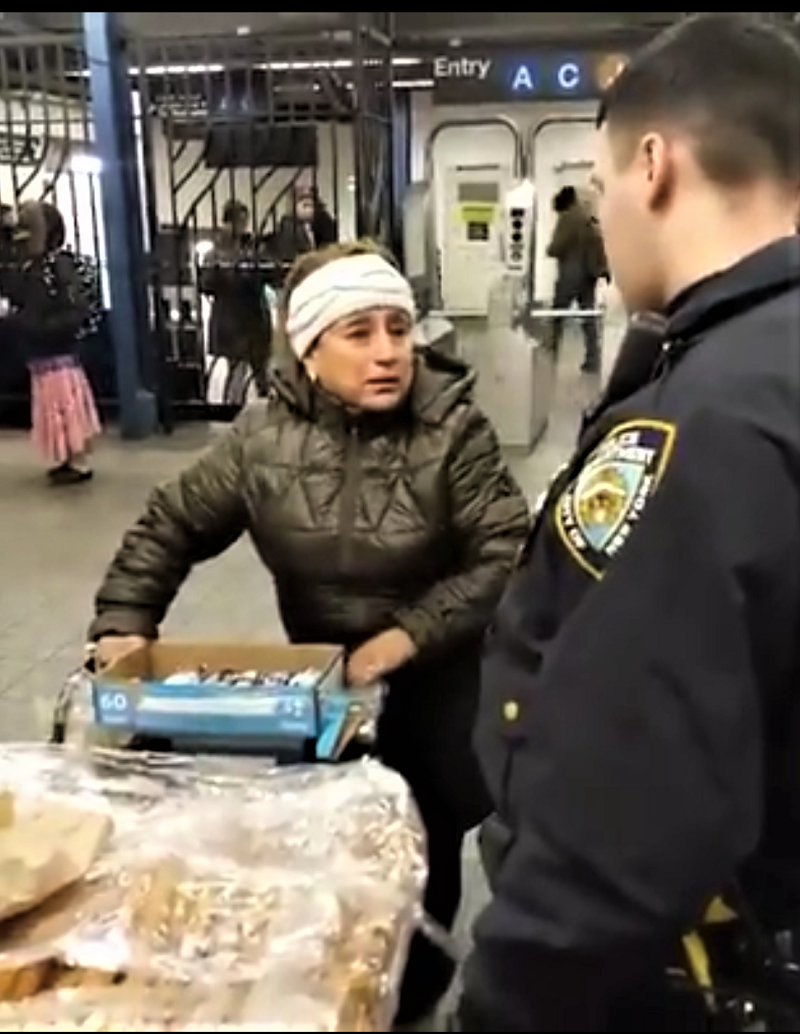
This month, six Black and Latino police officers filed suit against the New York Police Department. They faced retaliation, they said, for objecting to supervisors’ instructions to arrest Black and Latino people for subway fare evasion, and to ignore Asian and white people who don’t pay.
This suit confirms what oppressed youth here have known for some time. This city’s “solution” for a decrepit transit system is to scapegoat and arrest youth of color who can’t afford the $2.75 fare, and to charge them with “theft of services.”
New York City public transit has been called the worst public transit system of a major city in the world. Some 4.3 million people use New York City public transit every day. Most of those people are poor or working class. They rely on the subways, buses, bridges and tunnels to get them to work, school and medical appointments on time. They suffer the most when there is no service, and trains are late, or power goes out.
The New York City subway is falling apart because it is really controlled by banks and corporations and politicians that put profits before people, neglect the system and then use the police to maintain control.
Hidden history of the subways
New York’s subway system opened in 1904, at 5 cents a ride. With street transportation congested and unpredictable, the subways gave owners of factories and large-sale merchants access to a wider pool of workers who could arrive on the job in a timely manner.
The underground trains system was built and owned by private companies who kept the fare at 5 cents for 44 years. This was not out of any sense of fairness, or willingness to forgo profits, but because they feared the anger of the workers if they raised the fare.
To raise the fare and at the same time remove themselves from the target, these capitalists came up with a plan to transfer ownership of the subways to the government. They were not thinking about putting the subways in the hand of the people. They saw government ownership as transferring ownership from individual capitalists to the collective rule of the capitalist state, a state which primarily worked in their interests.
But the elected officials felt the heat too, and didn’t want to be held responsible by the public for a fare hike. So in 1953 the New York City Council created the Metropolitan Transit Authority and the Transit Authority to take the City Council, the mayor, the governor and state legislature and the corporations off the hook. With some minor regulation, the MTA and the TA regularly raised fares and cut the transit budget, and their existence diverted mass anger away from the capitalists and politicians.
MTA board: Millionaires from suburbs

Today Wall Street banks, the state, New York Governor Andrew Cuomo, Mayor Bill De Blasio, the MTA Board and MTA contractors and especially the banks manipulate the public transit system and the people to maintain power and to fatten profit margins. The MTA provides the cover. To make sure it worked in the interest of profit and not of public interest, the board is packed with millionaires and controlled by politicians.
The MTA Board’s 21 members are nominated by the governor. The mayor can recommend four seats for nomination. Six rotating, non-voting seats are held by representatives of organized labor and the Permanent Citizens Advisory Committee (PCAC). These non-voting seats, some 36 percent of the board, are supposed to represent the voice of MTA users. They actually live in the city.
The others, the 17 with the vote and the power, are millionaires who don’t even live in the city, but come from the suburbs.
How to get a MTA contract? Finance a politician
Elected officials receive campaign contributions from wealthy contractors in return for lucrative MTA contracts. While Governor Cuomo has been publicly critical of this practice, he too has received donations from MTA contractors. Since 2011, his campaigns have received $3 million from M.T.A. contractors and $1.5 million from donors with ties to the MTA, including board members. Elected officials and contractors continue to raid the public transit system and erode public trust.
The most expensive mile of track in the world
With contract distribution based on who contributes to what politician, the cost of maintenance and expansion has gone through the stratosphere. The estimated cost of the Long Island Rail Road project, known as “East Side Access,” has risen to $12 billion, or close to $3.5 billion for each new mile of track. This makes it the most expensive in the world per mile, most expensive in the world, and seven times the average elsewhere.
The recently completed Second Avenue subway on Manhattan’s Upper East Side and the 2015 extension of the No. 7 line to Hudson Yards also cost far above average, at $2.5 billion and $1.5 billion per mile, respectively.
The spending has taken place even as the MTA Board has repeatedly cut the transit budget and cut back on core subway maintenance. For decades, politicians have diverted money from the transit authority and saddled it with debt.
Workers pay fares, banks take the money
Wall Street banks are perhaps the biggest pillagers of the public transit system. The MTA’s debt is an amazing $34.1 billion. Deficit spending is a whopping 17 percent of the operating budget, making debt service and income payments are largest expense of the MTA. This debt continues to grow, and some expect it to be $42 billion by 2022.
Worst major transport system in the world
This focusing on profits and not people is responsible for the system wide problems include daily train delays, power outages, signal problems, overcrowding and aging infrastructure. As of five years ago, half of the 468 subway stations needed repairs. The Citizens Budget Commission estimates that at the current pace, the MTA would finish these repairs in 50 years.
The MTA board, however, hasn’t proposed canceling the debt to banks, or rooting out corruption and contact padding to raise money for repairs. Instead of taking measures that could really fix the quickly deteriorating transit system the Board is focused on increasing fares. Subway fares have increased every two years since 2009. These hikes unfairly burden poor and working-class people, who then become the target of police when they cannot afford to pay.
Fare evasion increased after the fare hike to $ 2.75 on April 21, when working class people already struggling to pay now had to choose between not using public transit or beating the fare.

Fare evaders are given a summons and a $100 ticket. This puts poor people with little financial resources at risk for further financial penalties and law enforcement involvement when they cannot afford to pay the fines.
MTA cops are mostly posted in impoverished Black and Latino neighborhoods. It is common to see officers hiding to catch fare beaters after they have entered the turnstile. This is not crime deterrence, this is entrapment.
Subway police protect capital and target the vulnerable
The MTA Board followed the April fare hike with a propaganda campaign linking the failing subways system to fare evasion. MTA is hiring an additional 500 cops on the Fare Enforcement Task Force, and dispatching them to subways to specifically target fare evaders, but also small-scale merchants and the homeless seeking shelter in the subways. Over the next 3 years the cost of the officers and supervisors will exceed $260 million, even though, by the city’s own figures, fare evasion has cost the city less than that — some $200 million. A harsher police presence is not only a waste of money, it has already led to increased violence against the public.
On Oct. 25 a group of cops entered a crowded subway care with guns drawn to arrest teenager Adrian Napier for fare evasion.
On Oct. 28, the police tasered a 16-year-old for jumping a turnstile.
In early November, MTA police arrested two women for selling churros in the train station. The women were were detained, given a summons and their food carts, the source of their livelihood, were taken away.
MTA for the people
Going even further, the Board recently voiced support for a lifetime ban on people repeatedly arrested in the subways, and floated the idea of publicly shaming fare evaders online. Meanwhile, the people who use the system have no real voice in how it is run, outside of sham public hearings that never lead to change.
But it’s the people who built public transport. It is our taxes and fares that keep the system going. It’s the MTA works who make the system run and keep it running. So it’s the working class that should control the public transit system. With workers in control, public transit could be free for everyone and a resource for the people, not a piggy bank for the rich.






